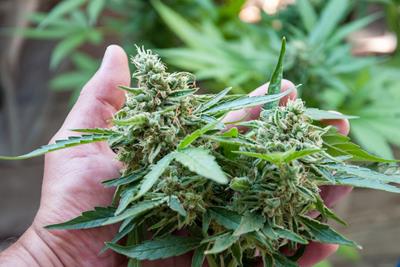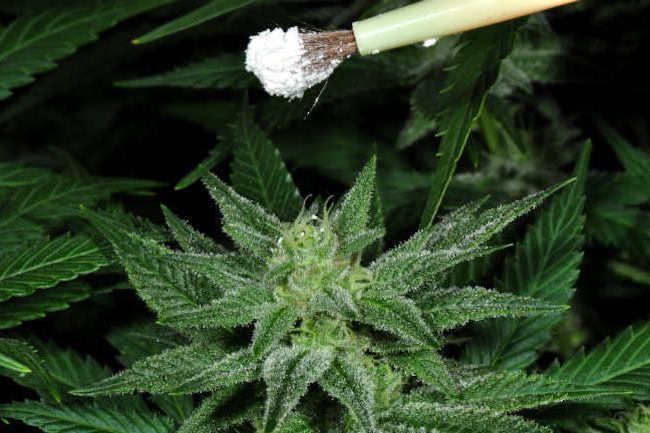
Monday January 10, 2022
By Erin Hiatt
 Growing
Growing
Nowadays, you can simply mosey on into your local dispensary and witness an abundance of dazzling varieties of cannabis flower. Whether it’s a terpene that suits your scent preferences, or cannabinoid ratio that targets your mood or ailment, you can get nearly anything you want.
However, maybe you’ve thought to yourself, “this Grandaddy Purps is okay, but I want bud that grows blue flower that tastes like diesel and chamomile and smells like a lemon tree that will also help my sciatica.” It’s only been since the 1960s that cannabis breeding has become the art form that it is, and new strains are being made every day, some of which hit the market with a massive splash and forever change the breed catalogue and wend their way into cannabis culture.
How to Make a New Mariuana Strain
How about it, then? Want to take a green-thumbed stab at making a new strain? All you’ll need is some time (as in many months of it), space, dedication, a penchant for record keeping, and some patience and luck.
Here’s a step-by-step to breeding a new marijuana strain.
- Have your pen and paper at the ready: before you dive into the how-to’s of making your own marijuana strain, you’ll want to get organized. Plan to label every plant and keep notes so you can track your progress
- Choose your plant parents: to cross-breed strains, you’ll need both male and female cannabis seeds. While the females eventually grow the cannabinoid-rich and terpene-laden flower, male plants play the crucial role of pollination and carry “silent traits” that pass crucial genetics like scent, for example.

- Plant your seeds in good soil: healthy soil can contribute to higher production, better plant strength, and provide the plant with the nutrients it needs. Look for a soil with a balance of macro and micronutrients and beneficial microbes
- Separate male and female plants: unless you want your new strain to be a random combo of genetics, keep male and female plants away from each other. At the very least, remove male plants at the beginning of their flowering stage to reduce accidental pollination.
Now you wait. Many breeders let their plants veg for around two months, but that time could be less or more depending on what you’ve planted. All you have to do during this time is ensure your plant’s health and keep an eye out for the maturation of the male plant’s pollen sacs. When they open and start to spill pollen, it’s time to move on to the next step.
- Collect pollen from male plants: there are a few ways to do this, but one simple way is to wrap a ziploc bag around the stem and shake the pollen into the bag. Other container options are to shake pollen into a bottle or jar. Alternatively, a nylon mesh screen could be used. Simply place the frame over a clean, dry container. Cut the stalks from male flowers one at a time, and shake or trim the branch over the screen so pollen falls through the screen to the container. The important thing is to keep plant matter and pollen separate
- Store pollen until it’s ready to pollinate female flowers: pollen can be stored in the freezer for up to a month, but make sure that it’s been separated from other plant matter that can introduce moisture into the pollen (not good)

- Pollinate female plants: when the white pistils on the female plant are standing, it’s time to pollinate. There are several ways to do this, from gently placing pollen on female stems to brushing the pistils delicately with a pollen-coated brush, to shaking a male plant in a room of females
- Deactivate the pollen: after about three or four hours, spray your plants with water
Then you wait some more. The next sign you’re looking for is the white pistil hairs to turn red or and orange and then the appearance of seeds. If all has gone well, the seeds should grow bigger and take on a dark brown, striped appearance. As excited as you might be that you’ve grown the seeds of your very own cross breed, hold off just a little bit longer. Wait until the husk is brown and fragile to ensure better seed quality.
- Collect the seeds: this process is time-consuming and messy, but seeds can be picked out one-by-one with tweezers or gloves (among several other methods depending upon your budget and infrastructure)
- Plant your seeds: germinate your seeds and watch them grow! Retrieve your pen and paper to take notes on key components like length of flowering stage, how the buds develop, their scent profile, etc.
If all has gone well, you’ve grown a marijuana strain of your own creation. Now onto the next challenge - choosing an awesome name.
Frequently Asked Questions
Can you breed cannabis?
You certainly can, even in a small space.
How long does it take to breed cannabis seeds?
Depending on what kind of parent seeds you’ve picked, it could take anywhere from 12 to 20 weeks-ish.
How long does it take to breed a new cannabis strain?
After you’ve grown your own strain seeds, you’ll have to start from scratch with your growing process. However, you’re in uncharted territory so it’s really difficult to know for sure. In general, indicas tend to grow faster than sativas, while hybrids tend to grow faster than both of them. Expect to be tied up for six to nine months or more.
Have you bred your own strains? How did it go?
Photo Credit: bondgrunge (license)







